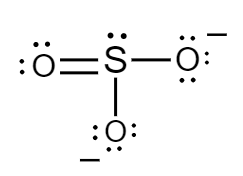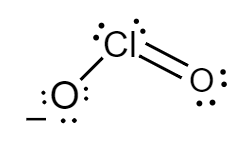
What are the formal charges on each atom in sulphite,
Answer
441k+ views
Hint: Formal charge is a theoretical value assigned to an atom in a molecule which reflects the equal sharing of electrons in a chemical bond, neglecting the electronegativity difference between the atoms. Sketch the Lewis diagram for the given ions to find the value of formal charge of each atom.
Complete answer:
The formal charge can be assigned to an atom with the help of following formula:
Where,
The Lewis structure for sulphite ions is as follows:

Formal charge for sulphur atom:
Number of electrons of sulphur in its ground state
Count of nonbonded electrons present on sulphur atom
Number of bonding electrons
Substituting values in equation
Formal charge for doubly bonded oxygen atom:
Number of electrons of oxygen in its ground state
Count of nonbonded electrons or number of lone pair of electrons present on oxygen atom
Number of bonding electrons
Substituting values in equation
Formal charge for single bonded oxygen atoms:
Number of electrons of oxygen in its ground state
Count of nonbonded electrons or number of lone pair of electrons present on oxygen atom
Number of bonding electrons
Substituting values in equation
Hence, in sulphite ions, the formal charge of sulphur atom, doubly bonded oxygen atom and singly bonded oxygen atoms is
The Lewis structure for chlorite ions is as follows:

Formal charge for chlorine atom:
Number of electrons of chlorine in its ground state
Count of nonbonded electrons present on chlorine atom
Number of bonding electrons
Substituting values in equation
Formal charge for doubly bonded oxygen atom:
Number of electrons of oxygen in its ground state
Count of nonbonded electrons or number of lone pair of electrons present on oxygen atom
Number of bonding electrons
Substituting values in equation
Formal charge for single bonded oxygen atom:
Number of electrons of oxygen in its ground state
Count of nonbonded electrons or number of lone pair of electrons present on oxygen atom
Number of bonding electrons
Substituting values in equation
Hence, in chlorite ions, the formal charge of chlorine atom, doubly bonded oxygen atom and singly bonded oxygen atom is
Note:
Lewis structures in which the formal charges are zero for most atoms in the compound, are more preferably considered than the one with non-zero formal charges. Moreover, the negative formal charge should be present on the most electronegative element in the compound.
Complete answer:
The formal charge can be assigned to an atom with the help of following formula:
Where,
The Lewis structure for sulphite ions is as follows:

Formal charge for sulphur atom:
Number of electrons of sulphur in its ground state
Count of nonbonded electrons present on sulphur atom
Number of bonding electrons
Substituting values in equation
Formal charge for doubly bonded oxygen atom:
Number of electrons of oxygen in its ground state
Count of nonbonded electrons or number of lone pair of electrons present on oxygen atom
Number of bonding electrons
Substituting values in equation
Formal charge for single bonded oxygen atoms:
Number of electrons of oxygen in its ground state
Count of nonbonded electrons or number of lone pair of electrons present on oxygen atom
Number of bonding electrons
Substituting values in equation
Hence, in sulphite ions, the formal charge of sulphur atom, doubly bonded oxygen atom and singly bonded oxygen atoms is
The Lewis structure for chlorite ions is as follows:

Formal charge for chlorine atom:
Number of electrons of chlorine in its ground state
Count of nonbonded electrons present on chlorine atom
Number of bonding electrons
Substituting values in equation
Formal charge for doubly bonded oxygen atom:
Number of electrons of oxygen in its ground state
Count of nonbonded electrons or number of lone pair of electrons present on oxygen atom
Number of bonding electrons
Substituting values in equation
Formal charge for single bonded oxygen atom:
Number of electrons of oxygen in its ground state
Count of nonbonded electrons or number of lone pair of electrons present on oxygen atom
Number of bonding electrons
Substituting values in equation
Hence, in chlorite ions, the formal charge of chlorine atom, doubly bonded oxygen atom and singly bonded oxygen atom is
Note:
Lewis structures in which the formal charges are zero for most atoms in the compound, are more preferably considered than the one with non-zero formal charges. Moreover, the negative formal charge should be present on the most electronegative element in the compound.
Latest Vedantu courses for you
Grade 11 Science PCM | CBSE | SCHOOL | English
CBSE (2025-26)
School Full course for CBSE students
₹41,848 per year
Recently Updated Pages
Master Class 11 Business Studies: Engaging Questions & Answers for Success

Master Class 11 Economics: Engaging Questions & Answers for Success

Master Class 11 Accountancy: Engaging Questions & Answers for Success

Master Class 11 Computer Science: Engaging Questions & Answers for Success

Master Class 11 English: Engaging Questions & Answers for Success

Master Class 11 Maths: Engaging Questions & Answers for Success

Trending doubts
The flightless birds Rhea Kiwi and Emu respectively class 11 biology CBSE

1 litre is equivalent to A 1000mL B 100cm3 C 10mL D class 11 physics CBSE

A car travels 100 km at a speed of 60 kmh and returns class 11 physics CBSE

Name the Largest and the Smallest Cell in the Human Body ?

Explain zero factorial class 11 maths CBSE

In tea plantations and hedge making gardeners trim class 11 biology CBSE




